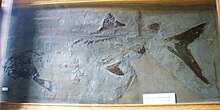
Acipenseriformes is an order of basal ray-finned fishes that includes living and fossil sturgeons and paddlefishes (Acipenseroidei), as well as the extinct families Chondrosteidae and Peipiaosteidae. They are the second earliest diverging group of living ray-finned fish after the bichirs. Despite being early diverging, they are highly derived, having only weakly ossified skeletons that are mostly made of cartilage, and in modern representatives highly modified skulls.
Chondrostei is a group of non-neopterygian ray-finned fish. While the term originally referred to the paraphyletic grouping of all non-neopterygian ray-finned fish, it was redefined by Patterson in 1982 to be a clade comprising the Acipenseriformes and their extinct relatives.

Caturus is an extinct genus of predatory marine fishes in the family Caturidae in the order Amiiformes, related to modern bowfin. It has been suggested that the genus is non-monophyletic with respect to other caturid genera.

Temnodontosaurus is an extinct genus of ichthyosaur from the Early Jurassic period. They lived between 200 and 175 million years ago (Hettangian-Toarcian) in what is now Western Europe and possibly Chile. It lived in the deeper areas of the open ocean. University of Bristol paleontologist Jeremy Martin described the genus Temnodontosaurus as "one of the most ecologically disparate genera of ichthyosaurs," although the number of valid Temnodontosaurus species has varied over the years.
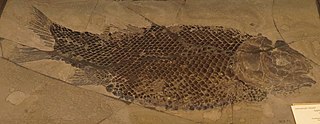
Lepidotes is an extinct genus of Mesozoic ray-finned fish. It has long been considered a wastebasket taxon, characterised by "general features, such as thick rhomboid scales and, for most of the species, by semi-tritorial or strongly tritorial dentition". with dozens of species assigned to it. Fossils attributed to Lepidotes have been found in Jurassic and Cretaceous rocks worldwide. It has been argued that Lepidotes should be restricted to species closely related to the type species L. gigas, which are only known from the Early Jurassic of Western and Central Europe, with most other species being not closely related, with other species transferred to new genera such as Scheenstia.Lepidotes belongs to Ginglymodi, a clade of fish whose only living representatives are the gars (Lepisosteidae). The type species L. gigas and close relatives are thought to be members of the family Lepidotidae, part of the order Lepisosteiformes within Ginglymodi, with other species occupying various other positions within Ginglymodi.

Stenopterygius is an extinct genus of thunnosaur ichthyosaur known from Europe.
Gyrosteus is an extinct genus of very large ray-finned fish belonging to the family Chondrosteidae. It comprises the type species, Gyrosteus mirabilis, which lived during the early Toarcian in what is now northern Europe. A possible second species, "Gyrosteus" subdeltoideus, is known from otoliths.
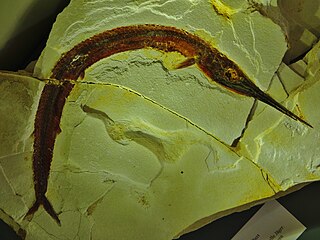
Belonostomus is a genus of prehistoric ray-finned fish that was described by Louis Agassiz in 1844. It is a member of the order Aspidorhynchiformes, a group of fish known for their distinctive elongated rostrums.

Birgeria is a genus of carnivorous marine ray-finned fish from the Triassic period. Birgeria had a global distribution, with fossil known from Madagascar, Spitsbergen, Germany, Switzerland, Italy, Slovenia, China, Russia, Canada and Nevada, United States. The oldest fossils are from Griesbachian aged beds of the Wordie Creek Formation of East Greenland. Birgeria existed throughout the entire Triassic period, from the very beginning just after the Permian-Triassic mass extinction, up to the very end with its extinction during the Triassic-Jurassic mass extinction.
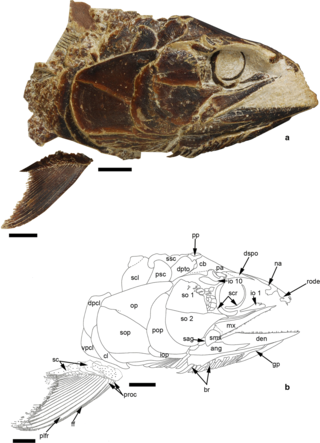
Pachycormus is an extinct genus of pachycormiform ray-finned fish known from the Early Jurassic of Europe. The type species P. macropterus was first named as a species of Elops by Henri Marie Ducrotay de Blainville in 1818, it was placed into the newly named genus Pachycormus by Louis Agassiz in 1833. Fossils have been found in marine deposits from France, Germany and England. Pachycormus has recently been considered monotypic, only containing P.macropterus, with other species considered junior synonyms of the former, though this has subsequently been questioned. Pachycormus has generally been considered basal among Pachycormiformes, with a recent phylogeny finding it to be the second most basal pachycormiform after Euthynotus. It grew up to 1 m (3.5 ft) in length. The teeth are short and designed for grasping. Its ecology has been interpreted as that of a generalist predator. Stomach contents indicate that its diet included cephalopods, and small fish, including juvenile Pachycormus.

Holophagus is an extinct genus of coelacanth belonging to Latimeriidae. The type species, Holophagus gulo, is known from the Lower Jurassic marine Lias of England. Some authors have considered the genus restricted to the Lias of England.
Paleopsephurus is an extinct genus of paddlefish (Polyodontidae). At present the genus contains the single species Paleopsephurus wilsoni. The genus is known from the Late Cretaceous (Maastrichtian) aged Hell Creek Formation of Montana.
Stichopterus is an extinct genus of chondrostean ray-finned fish that lived during the Early Cretaceous epoch in Asia. It has been found in Russia and Mongolia.

Strongylosteus is an extinct genus of prehistoric ray-finned fish that lived during the early Toarcian age of the Early Jurassic epoch. Its type species is Strongylosteus hindenburgi (monotypy). It is related to modern sturgeon and paddlefish (Acipenseroidei), but with a different kind of mouth than common species, made for hunting prey in open waters, with a strong lower jaw, similar to modern beluga sturgeon.
Psilichthys is an extinct genus of prehistoric bony fish from Eumeralla Formation, the Lower Cretaceous epoch of what is now Victoria, Australia, known from single species P. selwyni. This is the first Mesozoic fossil vertebrate named from Victoria.
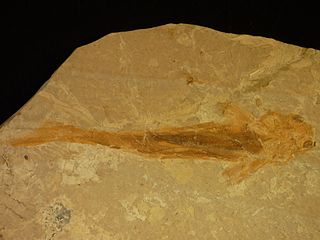
Peipiaosteus is an extinct genus of prehistoric chondrostean ray-finned fish. Its fossils are found in the Early Cretaceous Jiufotang Formation, Pani Lake, Liaoning Province, China.
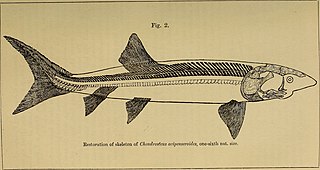
Chondrosteidae is a family of extinct marine actinopterygian fishes, known from the Early Jurassic of Europe. They are closely related to modern sturgeons and paddlefish of the order Acipenseriformes, and are either placed as part of that order or the separate order Chondrosteiformes within the Chondrostei. Three genera are known, Chondrosteus, Gyrosteus, and Strongylosteus. Included species were of large size, with body lengths ranging from 2 metres (6.6 ft) up to 7 metres (23 ft). Their skeleton was largely made up of bones, but ossification was reduced compared to other ray-fins.

Anningasaura is an extinct genus of basal plesiosaur. It is known from a single type species, A. lymense, discovered in Early Jurassic rocks of Lyme Regis in the United Kingdom.
Eochondrosteus is a genus of extinct actinopterygian, comprising one species, E. sinensis (monotypy) from the Early Triassic strata in Gansu Province, China. It is suggested to be the most basal acipenseriform. It was originally described in 2005, and then redescribed in 2020 in Chinese. Other authors have considered the placement of Eochondrosteus within the Acipenseriformes as tentative.

Coccolepididae is an extinct family of ray-finned fish, known from the Early Jurassic to Early Cretaceous, most of which were originally referred to the type genus Coccolepis. They had a widespread distribution, being found in North and South America, Australia, Asia and Europe. They are mostly known from freshwater environments, though several species have been found in marine environments. They are morphologically conservative, and have poorly ossified endo and exoskeletons, which usually results in poor preservation. This makes it difficult to distinguish species. They are generally small fish, with the largest known specimens reaching a length of 210 mm. Historically, they have been classified as members of “Palaeonisciformes”, a paraphyletic grouping of non-neopterygian fish, due to their plesiomorphic conservative morphology closely resembling those of many other groups of primitive fish. Some recent authors have suggested that they may belong to the order Chondrostei as relatives of the Acipenseriformes.
